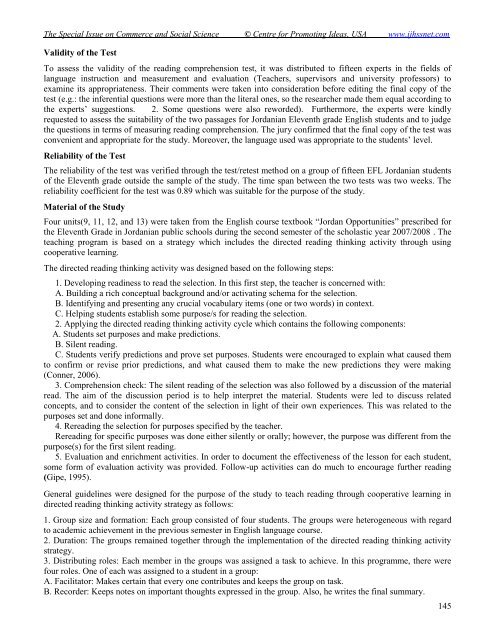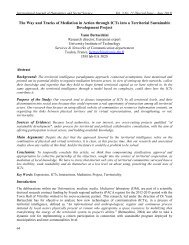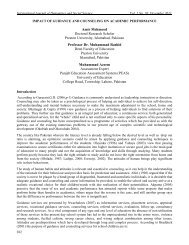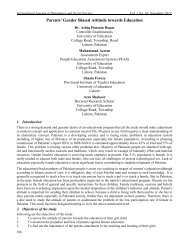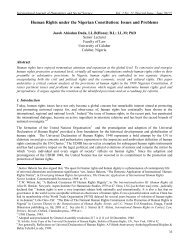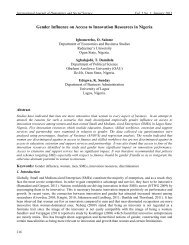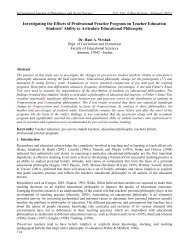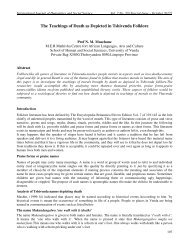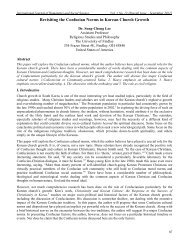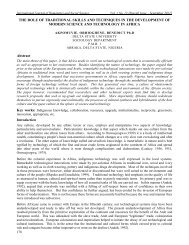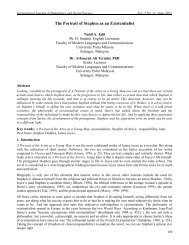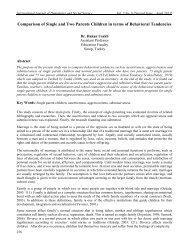The Effect of the Directed Reading Thinking Activity through ...
The Effect of the Directed Reading Thinking Activity through ...
The Effect of the Directed Reading Thinking Activity through ...
Create successful ePaper yourself
Turn your PDF publications into a flip-book with our unique Google optimized e-Paper software.
<strong>The</strong> Special Issue on Commerce and Social Science © Centre for Promoting Ideas, USA www.ijhssnet.com<br />
Validity <strong>of</strong> <strong>the</strong> Test<br />
To assess <strong>the</strong> validity <strong>of</strong> <strong>the</strong> reading comprehension test, it was distributed to fifteen experts in <strong>the</strong> fields <strong>of</strong><br />
language instruction and measurement and evaluation (Teachers, supervisors and university pr<strong>of</strong>essors) to<br />
examine its appropriateness. <strong>The</strong>ir comments were taken into consideration before editing <strong>the</strong> final copy <strong>of</strong> <strong>the</strong><br />
test (e.g.: <strong>the</strong> inferential questions were more than <strong>the</strong> literal ones, so <strong>the</strong> researcher made <strong>the</strong>m equal according to<br />
<strong>the</strong> experts’ suggestions. 2. Some questions were also reworded). Fur<strong>the</strong>rmore, <strong>the</strong> experts were kindly<br />
requested to assess <strong>the</strong> suitability <strong>of</strong> <strong>the</strong> two passages for Jordanian Eleventh grade English students and to judge<br />
<strong>the</strong> questions in terms <strong>of</strong> measuring reading comprehension. <strong>The</strong> jury confirmed that <strong>the</strong> final copy <strong>of</strong> <strong>the</strong> test was<br />
convenient and appropriate for <strong>the</strong> study. Moreover, <strong>the</strong> language used was appropriate to <strong>the</strong> students’ level.<br />
Reliability <strong>of</strong> <strong>the</strong> Test<br />
<strong>The</strong> reliability <strong>of</strong> <strong>the</strong> test was verified <strong>through</strong> <strong>the</strong> test/retest method on a group <strong>of</strong> fifteen EFL Jordanian students<br />
<strong>of</strong> <strong>the</strong> Eleventh grade outside <strong>the</strong> sample <strong>of</strong> <strong>the</strong> study. <strong>The</strong> time span between <strong>the</strong> two tests was two weeks. <strong>The</strong><br />
reliability coefficient for <strong>the</strong> test was 0.89 which was suitable for <strong>the</strong> purpose <strong>of</strong> <strong>the</strong> study.<br />
Material <strong>of</strong> <strong>the</strong> Study<br />
Four units(9, 11, 12, and 13) were taken from <strong>the</strong> English course textbook “Jordan Opportunities” prescribed for<br />
<strong>the</strong> Eleventh Grade in Jordanian public schools during <strong>the</strong> second semester <strong>of</strong> <strong>the</strong> scholastic year 2007/2008 . <strong>The</strong><br />
teaching program is based on a strategy which includes <strong>the</strong> directed reading thinking activity <strong>through</strong> using<br />
cooperative learning.<br />
<strong>The</strong> directed reading thinking activity was designed based on <strong>the</strong> following steps:<br />
1. Developing readiness to read <strong>the</strong> selection. In this first step, <strong>the</strong> teacher is concerned with:<br />
A. Building a rich conceptual background and/or activating schema for <strong>the</strong> selection.<br />
B. Identifying and presenting any crucial vocabulary items (one or two words) in context.<br />
C. Helping students establish some purpose/s for reading <strong>the</strong> selection.<br />
2. Applying <strong>the</strong> directed reading thinking activity cycle which contains <strong>the</strong> following components:<br />
A. Students set purposes and make predictions.<br />
B. Silent reading.<br />
C. Students verify predictions and prove set purposes. Students were encouraged to explain what caused <strong>the</strong>m<br />
to confirm or revise prior predictions, and what caused <strong>the</strong>m to make <strong>the</strong> new predictions <strong>the</strong>y were making<br />
(Conner, 2006).<br />
3. Comprehension check: <strong>The</strong> silent reading <strong>of</strong> <strong>the</strong> selection was also followed by a discussion <strong>of</strong> <strong>the</strong> material<br />
read. <strong>The</strong> aim <strong>of</strong> <strong>the</strong> discussion period is to help interpret <strong>the</strong> material. Students were led to discuss related<br />
concepts, and to consider <strong>the</strong> content <strong>of</strong> <strong>the</strong> selection in light <strong>of</strong> <strong>the</strong>ir own experiences. This was related to <strong>the</strong><br />
purposes set and done informally.<br />
4. Rereading <strong>the</strong> selection for purposes specified by <strong>the</strong> teacher.<br />
Rereading for specific purposes was done ei<strong>the</strong>r silently or orally; however, <strong>the</strong> purpose was different from <strong>the</strong><br />
purpose(s) for <strong>the</strong> first silent reading.<br />
5. Evaluation and enrichment activities. In order to document <strong>the</strong> effectiveness <strong>of</strong> <strong>the</strong> lesson for each student,<br />
some form <strong>of</strong> evaluation activity was provided. Follow-up activities can do much to encourage fur<strong>the</strong>r reading<br />
(Gipe, 1995).<br />
General guidelines were designed for <strong>the</strong> purpose <strong>of</strong> <strong>the</strong> study to teach reading <strong>through</strong> cooperative learning in<br />
directed reading thinking activity strategy as follows:<br />
1. Group size and formation: Each group consisted <strong>of</strong> four students. <strong>The</strong> groups were heterogeneous with regard<br />
to academic achievement in <strong>the</strong> previous semester in English language course.<br />
2. Duration: <strong>The</strong> groups remained toge<strong>the</strong>r <strong>through</strong> <strong>the</strong> implementation <strong>of</strong> <strong>the</strong> directed reading thinking activity<br />
strategy.<br />
3. Distributing roles: Each member in <strong>the</strong> groups was assigned a task to achieve. In this programme, <strong>the</strong>re were<br />
four roles. One <strong>of</strong> each was assigned to a student in a group:<br />
A. Facilitator: Makes certain that every one contributes and keeps <strong>the</strong> group on task.<br />
B. Recorder: Keeps notes on important thoughts expressed in <strong>the</strong> group. Also, he writes <strong>the</strong> final summary.<br />
145


